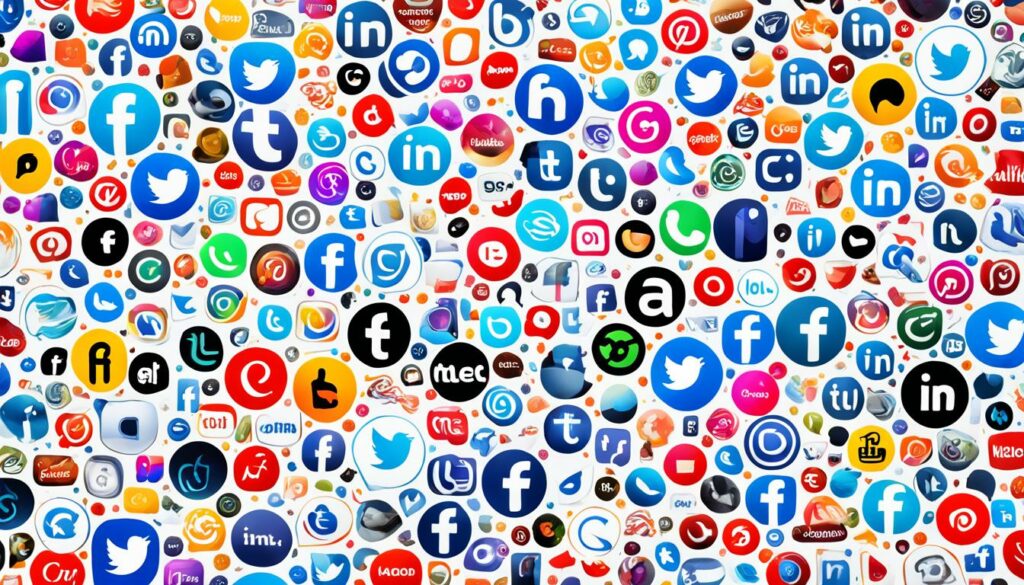Rise of Social Media: When It Gained Popularity
Social media platforms have experienced tremendous growth, with more than two-thirds of internet users utilizing these sites. The rise and widespread adoption of social media technologies have transformed various aspects of society, including the way people find partners, access news, and participate in political movements.
The history of social media begins in the early 2000s, with MySpace being the first site to reach a million monthly active users around 2004. Since then, social media platforms like Facebook, YouTube, and Twitter have experienced significant growth and evolution.
Usage of social media platforms varies among different population groups, with young people and specific demographics being more likely to use certain platforms. Additionally, social media has resulted in a significant increase in the amount of time people spend online, particularly through smartphones and tablets.
Key Takeaways:
- Social media gained popularity in the early 2000s, with MySpace being the first site to reach a million monthly active users.
- Platforms like Facebook, YouTube, and Twitter have experienced significant growth and evolution.
- Usage of social media platforms varies among different population groups.
- Social media has resulted in a significant increase in the amount of time people spend online.
- Social media adoption parallels that of other modern communication technologies, such as computers, smartphones, and the internet.
The Early Days of Social Media
The early 2000s marked the beginning of social media as we know it today. It was during this time that platforms like MySpace emerged, paving the way for the rise of social media. MySpace holds the distinction of being the first social media site to surpass one million monthly active users, achieving this milestone in 2004.
MySpace’s success was followed by the introduction of other popular platforms such as Facebook, YouTube, and Reddit, which have shaped the social media landscape over the past decade. While these platforms have become household names, newer players like TikTok have also made a significant impact in a relatively short period. In just two years after its 2016 launch, TikTok reached an impressive milestone of half a billion users.
The ever-evolving nature of social media has seen the emergence and decline of various platforms. Once-dominant sites like Hi5, MySpace, and Friendster have lost market share to the likes of Facebook, which has consistently remained the most popular social media platform worldwide. As of 2019, Facebook boasted over 2.3 billion users. Not far behind Facebook, other platforms like YouTube, Instagram, WeChat, Tumblr, and TikTok have also amassed hundreds of millions or even billions of users.
Throughout the years, social media platforms have undergone significant transformations and introduced new features to cater to the changing preferences and demands of users. The addition of video and image sharing capabilities, for example, has allowed users to share dynamic and visually engaging content. These developments have contributed to the continued popularity and relevance of social media in our digital age.
Social media platforms have shaped how people connect, share, and engage with content online. In the next section, we’ll explore how different population groups utilize social media and the demographics of its users.
Social Media Usage by Different Population Groups

Social media usage varies among different population groups. Young people, in general, are more likely to use social media than older individuals. This trend is pronounced for certain platforms like Snapchat and Instagram, which have a steep decline in popularity with age. For example, Snapchat is used by 73% of people under the age of 25, but only 3% of people over the age of 65. However, it is worth noting that the age gradient may narrow as today’s young people continue to use these platforms as they age.
Gender differences also exist in social media usage. For instance, Pinterest is three times more popular among women than men, while Reddit is twice as popular among men. These demographic differences highlight the diverse user base of social media platforms and their varying appeal to different segments of the population.
Social Media Usage by Age
The usage of social media platforms varies according to age groups. Younger individuals, particularly those under the age of 25, are more active on platforms like Snapchat and Instagram. These platforms provide a space for younger generations to connect, express themselves, and share their experiences. However, as individuals grow older, their usage of these platforms tends to decrease, with older age groups being less likely to engage with social media on a regular basis. It is important to note that this age gradient may change over time as younger generations continue using these platforms as they age.
Social Media Usage by Gender
Gender plays a role in social media usage patterns as well. Certain platforms have a higher popularity among specific genders. For example, Pinterest is predominantly used by women, who use the platform for creative inspiration, DIY projects, and lifestyle content. On the other hand, Reddit has a higher popularity among men, who engage with the platform for discussions, news, and niche interests. These gender differences reflect the diverse interests and preferences of social media users.
“Social media usage varies among different population groups. Young people, in general, are more likely to use social media than older individuals.”
– Social Media Analyst
Social Media Adoption Rates in Different Countries

Social media adoption rates vary across different countries, with significant differences observed in social media usage by country. In high-income countries like those in the Organisation for Economic Co-operation and Development (OECD), social media adoption is quite high, with nearly 90% of young adults actively using social media platforms. This indicates the widespread popularity and influence of social media among the younger population.
Moreover, social media usage rates are particularly high among specific demographics, such as individuals aged 16 to 24. This age group tends to embrace social media as a primary means of communication, entertainment, and information sharing.
While social media adoption differs from country to country, some nations exhibit remarkably high usage rates, with people spending an average of more than six hours per day on social media platforms. These numbers highlight the significant impact of social media in the lives of individuals across the globe.
For instance, in the United States, adults spend more than six hours daily on digital media, with smartphones and tablets being the primary devices driving this increase. This considerable amount of time spent on social media reflects the deep integration of these platforms into people’s daily lives and routines.
| Country | Social Media Adoption Rate (Percentage) | Average Time Spent on Social Media (Hours per Day) |
|---|---|---|
| United States | 70% | 6.3 |
| United Kingdom | 66% | 5.9 |
| Canada | 71% | 6.1 |
| Australia | 75% | 6.5 |
| Germany | 67% | 5.7 |
| India | 63% | 5.3 |
The table above provides a snapshot of social media adoption rates and the average time spent on social media in selected countries. These statistics demonstrate the global nature of social media usage and its impact on individuals and societies across the world.
As social media continues to evolve and permeate various aspects of our lives, monitoring and analyzing social media adoption rates by country will provide valuable insights into the changing landscape of digital communication and social interaction.
The Impact of Social Media on Communication and Culture

The rise of social media has revolutionized the way we communicate and shape our culture. These platforms have become integral to our lives, transforming how we interact, share information, and establish personal connections. With the ability to connect with friends, family, and communities regardless of geographical barriers, social media has become a powerful tool in bridging distances and fostering virtual relationships.
Social media platforms have also played a crucial role in driving social and political movements. They provide a platform for individuals to organize, voice their opinions, and demand change. Movements like the Arab Spring and the #BlackLivesMatter campaign gained significant traction and mobilization through social media, demonstrating its influence in shaping societal discourse.
In addition to its impact on communication, social media has greatly influenced our culture. It has become a space for self-expression, allowing individuals to share their thoughts, ideas, and creativity with a global audience. From viral challenges to influential content creators, social media has created new avenues for cultural expression and trends.
“Social media has transformed the way we connect and communicate, allowing us to foster relationships and share ideas on a global scale.”
The rapid diffusion of social media usage across the globe mirrors the adoption rates of other communication technologies. Just as computers, smartphones, and the internet have become indispensable parts of our lives, social media has become a central component of our daily routines.
While social media has undoubtedly connected people and accelerated cultural exchange, concerns have been raised regarding its impact on mental health and well-being. The constant exposure to carefully curated representations of others’ lives may contribute to feelings of inadequacy and anxiety. It is crucial to find a balance between the benefits and potential risks of social media usage.
| Positive Impacts | Negative Impacts |
|---|---|
| Instantaneous communication and global connections | Increased feelings of loneliness and disconnection |
| Amplifies marginalized voices and social movements | Risk of cyberbullying and online harassment |
| Platform for self-expression and creativity | Comparisons and negative self-perception |
As social media continues to evolve, its impact on communication and culture will only intensify. It is up to us as users and society as a whole to navigate the opportunities and challenges presented by this dynamic medium.
Social Media as a Marketing Tool

Social media platforms have become vital marketing tools for businesses. Companies utilize these platforms to engage with customers, promote their products and services, and build brand awareness. With the rise of social media marketing, businesses have found new and innovative ways to connect with their target audience.
Social media marketing is the process of using social media platforms to promote products and services, as well as engage with customers. It allows businesses to reach a wide audience, build brand loyalty, and drive traffic to their websites. Social media platforms offer various advertising options, such as sponsored posts, display ads, and promoted videos.
“Social media marketing allows businesses to connect with their target audience on a more personal level, leading to increased brand loyalty and customer engagement.” – Marketing Expert
One of the key advantages of marketing on social media is the ability to create and share content that resonates with your target audience. Businesses can leverage social media trends and insights to create compelling content that captures the attention of their followers. Creating high-quality and shareable content increases the chances of reaching a wider audience through shares and engagement.
Facebook, with nearly 1.7 billion users, remains a top social media platform for businesses to connect with their target market. Other popular platforms include Twitter, Instagram, Pinterest, and Snapchat, each offering unique features and demographics to cater to specific marketing needs.
Social Media Trends
Staying updated with the latest social media trends is crucial for businesses to remain competitive in the ever-evolving digital landscape. Here are some current social media trends:
- Video Content: The popularity of video content continues to rise, with platforms like YouTube and TikTok dominating the space. Businesses are utilizing video content to engage their audience, demonstrate products, and tell stories.
- Influencer Marketing: Collaborating with influencers to promote products or services has become a popular marketing strategy. Influencers have built dedicated followings and can help businesses reach new audiences.
- Stories: The ephemeral nature of stories on platforms like Instagram and Snapchat has captivated users. Businesses are leveraging this format to share behind-the-scenes content, limited-time offers, and exclusive updates.
- Personalization: Customers expect personalized experiences and communication. Businesses are leveraging data and analytics to deliver targeted content and ads to specific audiences.
These trends demonstrate the dynamic nature of social media marketing, requiring businesses to adapt and stay relevant to engage their target audience effectively.
Social Media Marketing Strategies
Successful social media marketing involves crafting effective strategies that align with business goals and target audience preferences. Here are some strategies to consider:
- Define Your Audience: Understand your target audience’s demographics, interests, and preferences to tailor your marketing messages and content effectively.
- Create Engaging Content: Develop high-quality and shareable content that captures your audience’s attention and encourages them to engage with your brand.
- Utilize Social Media Advertising: Leverage social media advertising options to expand your reach, target specific audiences, and drive traffic to your website or online store.
- Engage and Interact: Actively engage with your audience by responding to comments, messages, and mentions. Foster meaningful connections and build relationships with your followers.
- Measure and Analyze: Monitor the performance of your social media campaigns using analytics tools. Analyze data to make informed decisions and optimize your marketing strategies.
Remember, social media marketing is an ongoing process that requires constant adaptation and optimization to achieve optimal results.
Why Businesses Should Invest in Social Media Marketing
Social media marketing offers numerous benefits to businesses, making it an essential investment for success in the digital age. Some of the key advantages include:
- Increased Brand Awareness: Social media platforms allow businesses to reach a wider audience and build brand recognition.
- Enhanced Customer Engagement: Engaging with customers on social media enables businesses to build meaningful relationships and provide exceptional customer service.
- Targeted Advertising: Social media platforms provide advanced targeting options, allowing businesses to reach specific demographics and tailor their messaging accordingly.
- Cost-Effective Marketing: Compared to traditional advertising methods, social media marketing can be more cost-effective, with a higher return on investment.
- Data and Insights: Social media platforms offer valuable data and analytics to help businesses understand their audience, measure campaign performance, and make data-driven decisions.
As social media continues to evolve, businesses need to adapt their marketing strategies to leverage these platforms’ full potential.
| Social Media Platform | Monthly Active Users |
|---|---|
| 2.8 billion | |
| YouTube | 2 billion |
| 1.2 billion | |
| 330 million | |
| 400 million |
These statistics highlight the massive potential reach and impact that businesses can achieve through social media marketing.
In conclusion, social media platforms have become invaluable tools for businesses to connect with their audience, build brand awareness, and promote products and services. With the ever-changing social media landscape, businesses must stay updated on the latest trends and adapt their strategies to effectively engage their target market.
Technological Advancements and the Future of Social Media
The evolution of social media is closely intertwined with the progress of technology. As technology continues to advance, social media platforms have adapted and incorporated new features and capabilities, shaping the way we interact and engage online.
One significant development that has transformed social media is the widespread adoption of mobile devices. The convenience and accessibility of smartphones have turned social media into a primarily mobile experience. Platforms like Instagram, with their focus on visual content and mobile-friendly experiences, have gained immense popularity.
Looking ahead, technological advancements such as artificial intelligence (AI) and virtual reality (VR) are expected to revolutionize social media further. AI-powered algorithms will enhance user experience by personalizing content and recommendations, while VR will enable immersive and interactive social media experiences.
“The integration of artificial intelligence and virtual reality in social media will offer new avenues for communication, creating more engaging and immersive experiences for users.” – [Expert Name]
This convergence of technology and social media will likely lead to new ways of communication, bringing people closer together in virtual spaces. Additionally, social media will become increasingly integrated into our daily lives, seamlessly connecting us with others and the world around us.
Staying up to date with technological trends and innovations is crucial for businesses and individuals alike. By embracing and leveraging the power of social media technology, we can unlock new opportunities for communication, collaboration, and marketing strategies.
The Future of Social Media: Key Technological Trends
- Artificial Intelligence (AI): AI will power advanced algorithms for personalized content, chatbots for customer service, and sentiment analysis for understanding audience preferences and behavior.
- Virtual Reality (VR): VR will enable users to immerse themselves in virtual environments, facilitating interactive social experiences and opening new possibilities for entertainment, education, and communication.
- Augmented Reality (AR): AR overlays virtual elements onto the real world, enhancing social media experiences by merging digital and physical realities. From AR filters to location-based information, AR will bring a new dimension to social media interaction.
- Blockchain Technology: Blockchain can enhance security, transparency, and privacy in social media, providing users with more control over their data and protecting against fraudulent activities.
- Live Video Streaming: Real-time video streaming will continue to dominate social media, allowing users to share live moments and engage with their audience in a more authentic and immediate way.
Incorporating these technological advancements into social media platforms will shape the future of communication, community-building, and content creation. By embracing these innovations, social media will continue to evolve and redefine the way we connect and engage with others.
Technological advancements are paving the way for the future of social media.
Privacy and Ethical Considerations in Social Media
The widespread use of social media has raised important privacy and ethical concerns. Social media platforms collect vast amounts of user data, which can be used for targeted advertising and personalization. This has led to debates around data privacy and the ethical use of user information.
Additionally, the spread of misinformation and fake news on social media platforms has raised concerns about the platform’s responsibility to combat false information. Users are often exposed to misleading or inaccurate content, which can have serious consequences for individuals and society.
Privacy policies and regulations, such as the General Data Protection Regulation (GDPR), aim to protect user privacy and ensure ethical practices in the handling of user data. These regulations require companies to obtain clear consent from users before collecting their data and provide options for users to control how their data is used.
Addressing Privacy and Ethics
Social media platforms have taken steps to address privacy and ethical concerns. For example, they have implemented privacy settings that allow users to control who can view their posts and personal information. Users can choose to make their profiles private, limiting access to their content.
Additionally, social media platforms have implemented reporting systems that allow users to flag inappropriate or false content. These systems help identify and remove content that violates the platform’s community standards and guidelines.
“Social media platforms play a crucial role in ensuring data privacy and ethical practices. It is essential for users to understand and leverage the privacy settings available to protect their personal information.” – Emily Johnson, Privacy Advocate
However, privacy and ethical challenges continue to evolve as social media platforms and technologies advance. New concerns emerge as platforms introduce new features and collect more data from users. It is important for users to stay informed about their rights and take steps to protect their privacy online.
The Future of Privacy and Ethics in Social Media
As social media continues to evolve, it is likely that privacy and ethics will remain key concerns. Users and regulators will demand greater transparency and accountability from social media platforms. Stricter regulations may be introduced to protect user data and ensure ethical practices.
Advancements in technology, such as blockchain and decentralized networks, may also play a role in addressing privacy and ethical concerns in social media. These technologies offer the potential for users to have greater control over their personal data and prevent unauthorized access.
Overall, privacy and ethical considerations are essential in the ever-growing world of social media. It is crucial for both users and social media platforms to prioritize data privacy and ethical practices to ensure a safe and trustworthy online environment.
Conclusion
The evolution of social media has revolutionized how we communicate, share information, and interact with businesses. From the early days of platforms like MySpace and Facebook to the current dominance of Instagram and TikTok, social media has become an integral part of our daily lives. The rapid adoption and widespread usage of social media reflect the changing landscape of communication technologies and the increasing importance of digital connectivity.
As social media continues to evolve, it brings with it new challenges and opportunities. Privacy and ethical considerations surrounding data collection and the spread of misinformation are critical topics that require attention. In this digital age, businesses, individuals, and society as a whole must navigate these issues and adapt to the changing dynamics of social media.
The future of social media holds great promise. As technological advancements such as artificial intelligence and virtual reality continue to shape the digital landscape, social media will likely become even more immersive and integrated into our daily lives. This presents both exciting possibilities and challenges for users and marketers alike.
In conclusion, social media’s impact on society has been profound. It has transformed the way we communicate, connect, and consume information. As we move forward, it is crucial to be mindful of the privacy, ethical, and cultural considerations that come with the evolution of social media. By embracing the opportunities and addressing the challenges, we can shape a future where social media continues to enhance our lives and foster meaningful connections.
FAQ
When did social media get popular?
Social media started gaining popularity in the early 2000s, with MySpace being the first social media site to reach a million monthly active users around 2004.
What were the early days of social media like?
The early days of social media were characterized by platforms like MySpace and Facebook, which paved the way for the widespread adoption of social networking.
How does social media usage vary among different population groups?
Social media usage varies among different population groups, with young people being more likely to use platforms like Snapchat and Instagram, while older individuals may prefer other platforms like Facebook.
How does social media adoption rates vary across different countries?
Social media adoption rates vary across different countries, with high-income countries showing higher usage rates, especially among young adults. However, social media usage is on the rise globally.
What impact has social media had on communication and culture?
Social media has transformed the way people communicate, express themselves, and engage with others. It has also played a significant role in organizing social and political movements.
How is social media used as a marketing tool?
Social media has become an essential marketing tool for businesses. It allows companies to engage with customers, promote their products, and build brand awareness through advertising and content creation.
How are technological advancements shaping the future of social media?
Technological advancements like artificial intelligence and virtual reality are expected to shape the future of social media by introducing new communication methods and immersive experiences.
What are the privacy and ethical concerns associated with social media?
Social media platforms raise concerns about privacy and the ethical use of user data. Additionally, the spread of misinformation and fake news is a growing concern that platforms must address.
What is the summary of the social media evolution?
Social media has experienced significant growth and evolution since its early days, transforming communication, culture, and marketing. It continues to evolve with the advancement of technology, presenting both opportunities and challenges.







